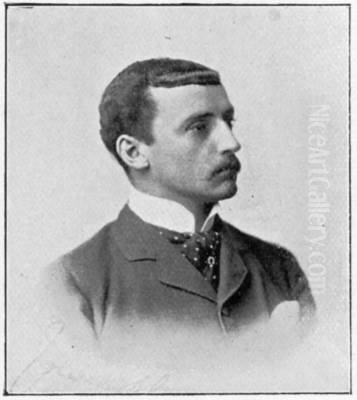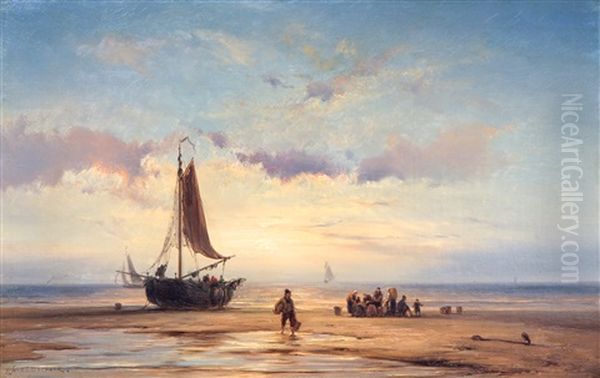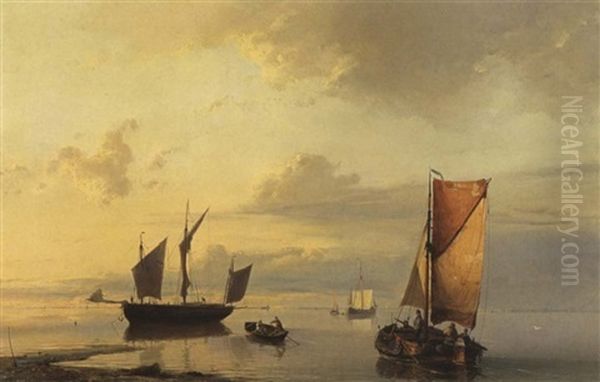
Johannes Hermanus Barend Koekkoek (1840-1912) stands as a significant figure in the rich tapestry of 19th-century Dutch painting. Born into a veritable dynasty of artists, he carved his own niche, primarily as a master of marine and coastal scenes, and later, evocative landscapes. His work bridges the romantic sensibilities inherited from his forebears with the emerging realism of his time, particularly the influence of the Hague School. This article delves into the life, art, and enduring legacy of this talented painter, situating him within his famed family and the broader artistic currents of his era.
The Illustrious Koekkoek Dynasty
To understand Johannes Hermanus Barend Koekkoek, one must first appreciate the artistic lineage from which he sprang. The Koekkoek family was, and remains, one of the most celebrated artistic families in the Netherlands, spanning several generations and producing painters of remarkable skill in various genres, though predominantly landscapes and marine subjects.
The dynasty's founder was Johannes Hermanus Koekkoek (1778-1851), J.H.B.'s grandfather. He was a distinguished marine painter, renowned for his meticulously detailed and atmospherically charged depictions of Dutch shipping, coastal views, and seascapes, often capturing the dramatic interplay of light and weather. His works set a high standard for realism and technical finesse in marine art.
Johannes Hermanus Koekkoek had four sons who all became painters:
First, Barend Cornelis Koekkoek (1803-1862), J.H.B.'s uncle, was arguably the most famous member of the family, often dubbed the "Prince of Landscape Painters." He achieved international acclaim for his romantic landscapes, particularly his majestic forest scenes and winter vistas, characterized by dramatic lighting and meticulous detail. B.C. Koekkoek founded an influential drawing academy in Kleve, Germany, and his work profoundly shaped the course of Dutch Romantic landscape painting. His students included figures like Willem Bodeman and Johann Bernard Klombeck, who carried on his romantic ideals.
Second, Marinus Adrianus Koekkoek (1807-1868), another uncle of J.H.B., also specialized in landscapes and animal paintings, often imbued with a romantic, idyllic quality. His works, while perhaps less internationally renowned than B.C.'s, contributed to the family's reputation for landscape artistry.

Third, Johannes Koekkoek (1811-1831), who showed promise but died young, also focused on landscapes and marine subjects, following the family tradition.
Fourth, and crucially for J.H.B., was his father, Hermanus Koekkoek Sr. (1815-1882). Hermanus Sr. was a highly accomplished marine and river scene painter, working in a style that combined the meticulous detail of his father with a slightly more fluid and atmospheric approach. He was a respected artist in his own right and served as the primary artistic mentor for his son, Johannes Hermanus Barend.
The artistic gene continued into J.H.B.'s generation and beyond. His brothers, Willem Koekkoek (1839-1895), became known for his detailed townscapes, and Hermanus Koekkoek Jr. (1836-1909), also painted marine and river scenes. This familial immersion in art provided an unparalleled environment for the young Johannes Hermanus Barend.
Early Life and Artistic Formation
Johannes Hermanus Barend Koekkoek was born in Amsterdam on October 6, 1840. Growing up surrounded by painters, with a studio practically in his home, his path towards an artistic career seemed almost preordained. His earliest and most significant instruction came from his father, Hermanus Koekkoek Sr. From him, J.H.B. learned the fundamentals of drawing, composition, and oil painting, with a particular emphasis on the accurate depiction of ships, water, and atmospheric effects – hallmarks of the Koekkoek marine tradition.
While formal records of his attendance at the Rijksakademie van Beeldende Kunsten (Royal Academy of Fine Arts) in Amsterdam are not as prominent as for some of his relatives, it is highly probable he received some academic training there, supplementing the intensive tutelage from his father. The artistic environment of Amsterdam, a bustling port city with a rich maritime history, undoubtedly provided ample inspiration for his early focus on marine subjects. He would have been exposed to the works of contemporary Dutch marine painters as well as the legacy of the Golden Age masters like Willem van de Velde the Younger.
His grandfather, Johannes Hermanus Koekkoek, though passing away when J.H.B. was only eleven, would have left a lasting impression through his works and reputation. Similarly, the towering success of his uncle, Barend Cornelis Koekkoek, in the realm of landscape painting, demonstrated the possibilities and prestige achievable within the art world.
Development of a Distinctive Style: From Romanticism to Realism

J.H.B. Koekkoek began his career firmly rooted in the Romantic tradition that characterized much of his family's output. His early marine paintings exhibit the meticulous detail, dramatic lighting, and often, the narrative elements typical of 19th-century Romantic seascapes. He skillfully depicted various types of sailing vessels, from humble fishing boats to larger merchant ships, navigating calm estuaries or braving choppy coastal waters. His ability to render the texture of sails, the wood of hulls, and the reflective or turbulent nature of water was exceptional.
He worked in Amsterdam initially, then moved to Nieuwer-Amstel (now Amstelveen) in the late 1860s. A significant shift occurred in his life and art when he subsequently moved to Hilversum in the Gooi region. This area, with its heathlands, woods, and picturesque villages, began to feature more prominently in his work. While he never entirely abandoned marine subjects, his focus broadened to include landscapes, often depicting the tranquil Dutch countryside.
It was during his time in Hilversum, and through his exposure to the evolving artistic climate, that J.H.B. Koekkoek's style began to absorb influences from the Hague School. This influential group of artists, including figures like Jozef Israëls, Hendrik Willem Mesdag, Anton Mauve, Jacob Maris, and Willem Maris, had moved away from the idealized drama of Romanticism towards a more direct, naturalistic depiction of Dutch life and landscape. They favored muted palettes, atmospheric effects achieved through subtle tonal gradations, and everyday subjects.
J.H.B. Koekkoek did not become a Hague School painter in the strictest sense, but his later works, particularly his landscapes and some coastal scenes, show a clear affinity with their aesthetic. His brushwork became somewhat looser, his palette more subdued, and his compositions often emphasized mood and atmosphere over precise topographical detail. He became particularly adept at capturing the soft, diffused light of the Dutch coast and countryside.
Key Themes and Subjects
Throughout his career, J.H.B. Koekkoek explored several recurring themes and subjects, showcasing his versatility and keen observational skills.
Marine and Coastal Scenes: This remained a cornerstone of his oeuvre. He painted a wide array of maritime subjects:
Shipping in Calms: Tranquil scenes of boats at anchor or gently sailing in calm estuaries or near the coast, often under soft, hazy skies.
Rough Seas and Storms: More dramatic depictions of vessels battling wind and waves, showcasing his ability to convey the power of nature.
Fishing Boats and Fisherfolk: Scenes of daily life along the coast, with fishing boats (<em>bomschuiten</em>) being launched or returning, and fisherfolk engaged in their activities on the beaches. These often have a strong narrative and human interest element.

Harbor Views: Less common, but he did paint some scenes of bustling harbor activity.
River Landscapes: Often extensions of his marine interests, these works depicted life along the Dutch rivers, with sailing barges, windmills, and riverside villages. They allowed for a blend of water and land elements, showcasing his skill in both.
Pure Landscapes: Especially after his move to Hilversum, he produced landscapes featuring the heathlands, woods, and rural paths of the Gooi region. These works often have a quiet, contemplative mood, reflecting the Hague School's influence. He was particularly skilled at rendering the subtle play of light on foliage and the expansive Dutch skies.
Beach Scenes: A subset of his coastal scenes, these often focused on the activities of fisherfolk on the shore, the vastness of the beach under changing skies, and the characteristic flat-bottomed fishing boats pulled up on the sand.
Representative Works
While it is challenging to single out a few works from a prolific career, certain paintings exemplify J.H.B. Koekkoek's style and thematic concerns.
One notable example often cited is Fisherman's House in the Dunes. This work likely showcases his ability to blend landscape and genre elements, depicting a humble dwelling nestled in the coastal dunes, a common sight along the Dutch coast. Such a painting would highlight his skill in rendering the textures of sand and marram grass, the specific light of the coast, and the human element within the natural environment. The mood would likely be one of quiet resilience, typical of scenes depicting the lives of fishing communities.
Other typical titles that recur in auction catalogues and collections give a sense of his output:
Shipping in a Breeze off the Coast: This would capture his skill in depicting movement, the tautness of sails, and the dynamic surface of the water.
A Calm Estuary with Fishing Smacks: Exemplifying his quieter, more atmospheric scenes, focusing on reflections and the soft interplay of light.
Figures on a Beach with Fishing Boats at Scheveningen: Scheveningen was a popular subject for many Dutch painters, including Hague School artists like Mesdag. Koekkoek's interpretations would focus on the daily activities and the characteristic coastal light.
A Wooded Landscape with a Drover and Cattle: Representative of his later landscape work, showing his ability to capture the rustic charm of the Dutch countryside, possibly with a more subdued, naturalistic palette.
His works are generally characterized by a high level of technical competence, a fine sense of composition, and an acute sensitivity to light and atmosphere.
Artistic Technique and Palette
J.H.B. Koekkoek was a technically proficient painter, a skill honed from his early training with his father. His early works, in the Romantic vein, display a fine, detailed brushwork, particularly in the rendering of ships and rigging. He paid close attention to the accurate depiction of different types of vessels and the effects of light on water and sails.
As his style evolved under the influence of the Hague School, his brushwork often became somewhat broader and more suggestive, particularly in his landscapes and skies. He was less concerned with minute detail and more focused on capturing the overall mood and atmospheric conditions. However, he never fully abandoned the careful draftsmanship that was a hallmark of the Koekkoek family.
His palette also underwent a transformation. Early marine scenes might feature brighter blues, crisp whites, and dramatic contrasts in line with Romantic conventions. His later works, especially landscapes, tend towards the more muted, tonal palette favored by the Hague School – soft greens, earthy browns, greys, and silvery blues. He was a master of depicting the diffused, often silvery light characteristic of the Dutch climate, whether it was the bright haze of a summer day on the coast or the melancholic light of an overcast sky.
He typically painted in oils on canvas, though sometimes on panel, especially for smaller studies. His compositions are generally well-balanced, often employing traditional perspectival techniques to create a sense of depth and space. Diagonals are frequently used to lead the viewer's eye into the scene, whether it's a receding coastline, a line of boats, or a path winding through a landscape.
The Context of Dutch Romanticism and the Hague School
J.H.B. Koekkoek's career spanned a period of significant transition in Dutch art. He began painting when Dutch Romanticism was at its zenith, an era dominated by figures like his uncle Barend Cornelis Koekkoek, Andreas Schelfhout (renowned for his winter landscapes and marines), and Wijnand Nuijen (known for his dramatic landscapes and townscapes). Romanticism in the Netherlands emphasized the picturesque, the idyllic, and sometimes the sublime aspects of nature, often with a nostalgic nod to the Golden Age. Marine painting, a genre with deep roots in Dutch art, was a vital part of this Romantic expression, with artists like Johannes Christiaan Schotel and Louis Meijer also making significant contributions.
By the mid-19th century, however, a new sensibility began to emerge, leading to the formation of the Hague School around the 1870s. This movement sought a more truthful and unadorned representation of Dutch reality. Artists like Jozef Israëls (depicting the hard lives of fisherfolk and rural peasants), Hendrik Willem Mesdag (famous for his panoramic views of the Scheveningen coast), Anton Mauve (known for his gentle landscapes with sheep or cattle), Jacob Maris (powerful depictions of Dutch towns and skies), his brother Willem Maris (luminous scenes of cattle by water), Johannes Bosboom (atmospheric church interiors), and Paul Gabriël (polder landscapes under expansive skies) were central to this new direction. The influence of French Barbizon School painters like Jean-Baptiste-Camille Corot and Jean-François Millet was also significant for the Hague School.
J.H.B. Koekkoek navigated this changing artistic landscape adeptly. While his foundations were Romantic, his later work clearly shows an engagement with the principles of the Hague School, particularly in its emphasis on atmosphere, tonal harmony, and a more naturalistic approach to subject matter. He managed to synthesize these influences into a personal style that retained a degree of Romantic charm while embracing a more contemporary realism.
Contemporaries and Artistic Milieu
Beyond the major figures of Romanticism and the Hague School, J.H.B. Koekkoek was part of a vibrant artistic community. In Amsterdam and later in Hilversum, he would have interacted with numerous other painters. The art societies, exhibitions, and dealers of the time fostered a dynamic environment.
Other marine painters active during parts of his career included Vilhelm Melbye, a Danish artist who also worked in the Netherlands and was known for his dramatic seascapes. In landscape, artists like Cornelis Springer, though primarily a townscape painter, shared a meticulous approach to detail seen in earlier Koekkoek works. The shift towards realism was a broad trend, and many artists, like J.H.B. Koekkoek, adapted their styles to varying degrees. His own family members, including his brothers Willem and Hermanus Jr., were also part of this milieu, each contributing to the diverse artistic output of the period.
Later Career, Recognition, and Legacy
Johannes Hermanus Barend Koekkoek continued to paint actively throughout his life. He exhibited his works in various Dutch cities, including Amsterdam, Rotterdam, and The Hague, gaining recognition for his skill and the appealing nature of his subjects. His paintings found favor with the burgeoning middle-class art market, which appreciated well-crafted, evocative depictions of Dutch scenery and maritime life.
He passed away in Hilversum on January 24, 1912. His legacy is that of a highly skilled and adaptable painter who successfully carried the Koekkoek family's artistic tradition into the early 20th century. He was not an avant-garde revolutionary, but rather an artist who understood and masterfully executed the prevailing tastes of his time, while subtly incorporating new artistic ideas.
His influence can be seen in the continuation of high-quality marine and landscape painting in the Netherlands. While the major artistic innovations of the early 20th century would move in different directions (towards Post-Impressionism, Expressionism, and abstraction), the tradition of realistic and atmospheric depiction of the Dutch environment, which Koekkoek upheld, retained its appeal.
Koekkoek's Works in Collections and the Art Market
Today, works by Johannes Hermanus Barend Koekkoek are held in numerous private collections in the Netherlands and internationally. While perhaps not as ubiquitously present in major public museums as those of his uncle B.C. Koekkoek or leading Hague School figures, his paintings do appear in regional Dutch museums and are regularly featured in specialized exhibitions on 19th-century Dutch art.
His paintings consistently perform well on the art market. Auction houses like Sotheby's, Christie's, and prominent Dutch auctioneers frequently offer his works, which are sought after by collectors of 19th-century European art. The prices achieved vary depending on size, subject matter, period, and condition, but his well-executed marine scenes and atmospheric landscapes command respectable sums.
Specific examples mentioned in auction records include:
A View near Veere , a smaller panel, indicative of his landscape work.
Busy Quayside , a larger canvas showcasing his ability to handle complex scenes with multiple figures and vessels.
Fisherfolk on the Beach , a medium-sized work capturing a typical coastal genre scene.
Shipping in a Calm , a classic marine subject.
Shipwreck , demonstrating his capacity for more dramatic marine narratives.
A Small Boat in the Breakers , focusing on the interaction of small craft with the powerful sea.
These records attest to the enduring appeal of his art, valued for its technical quality, its charming depiction of Dutch life and scenery, and its connection to the esteemed Koekkoek name.
Conclusion
Johannes Hermanus Barend Koekkoek was a distinguished painter who made a significant contribution to Dutch art in the second half of the 19th and early 20th centuries. As a scion of the renowned Koekkoek dynasty, he inherited a formidable artistic legacy, particularly in marine painting, which he honored and developed with his own distinct sensibility. His ability to adapt his style, absorbing the atmospheric realism of the Hague School while retaining a degree of Romantic allure, speaks to his artistic intelligence and versatility.
His depictions of the Dutch coast, its fishing communities, the ever-changing sea, and the tranquil inland landscapes continue to resonate with viewers today. They offer a window into a bygone era, rendered with a skill and sensitivity that affirm his place as a noteworthy artist within the rich tradition of Dutch painting. His works remain a testament to the enduring beauty of the Dutch environment and the artistic family that so masterfully captured its essence.